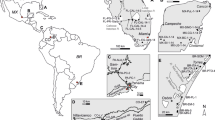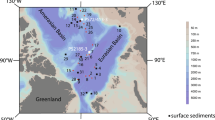Abstract
Oxygen isotope ratios of well-preserved brachiopod calcite and conodont apatite were used to reconstruct the palaeotemperature history of the Middle and Late Devonian. By assuming an oxygen isotopic composition of −1‰ V-SMOW for Devonian seawater, the oxygen isotope values of Eifelian and early Givetian brachiopods and conodonts give average palaeotemperatures ranging from 22 to 25 °C. Late Givetian and Frasnian palaeotemperatures calculated from δ18O values of conodont apatite are close to 25 °C in the early Frasnian and increase to 32 °C in the latest Frasnian and early Famennian. Oxygen isotope ratios of late Givetian and Frasnian brachiopods are significantly lower than equilibrium values calculated from conodont apatite δ18O values and give unrealistically warm temperatures ranging from 30 to 40 °C. Diagenetic recrystallization of shell calcite, different habitats of conodonts and brachiopods, as well as non-equilibrium fractionation processes during the precipitation of brachiopod calcite cannot explain the 18O depletion of brachiopod calcite. Moreover, the 18O depletion of brachiopod calcite with respect to equilibrium δ18O values calculated from conodont apatite is too large to be explained by a change in seawater pH that might have influenced the oxygen isotopic composition of brachiopod calcite. The realistic palaeotemperatures derived from δ18O apatite may suggest that biogenic apatite records the oxygen isotopic composition and palaeotemperature of Palaeozoic oceans more faithfully than brachiopod calcite, and do not support the hypothesis that the 18O/16O ratio of Devonian seawater was significantly different from that of the modern ocean.





Similar content being viewed by others
References
Auclair AC, Joachimski MM, Lécuyer C (2003) Deciphering kinetic, metabolic and environmental controls on stable isotope fractionations between seawater and the shell of Terebratalia transversa (Brachiopoda). Chem Geol 202:59–78
Bates NR, Brand U (1991) Environmental and physiological influences on isotopic and elemental compositions of brachiopod shell calcite: implications for the isotopic evolution of Palaeozoic oceans. Chem Geol 94:67–78
Brand U (1989) Global climatic changes during the Devonian-Mississippian: stable isotope biogeochemistry of brachiopods. Palaeogeogr Palaeoclimatol Palaeoecol 75:311–329
Brand U, Logan A, Hiller N, Richardson J (2003) Geochemistry of modern brachiopods: applications and implications for oceanography and palaeoceanography. Chem Geol 198:305–334
Brock TD (1985) Life at high temperatures. Science 230:132–138
Bruckschen P, Oesmann S, Veizer J (1999) Isotope stratigraphy of the European Carboniferous: proxy signal for ocean chemistry, climate and tectonics. Chem Geol 161:243–264
Bryant JD, Koch PL, Froelich PN, Showers WJ, Genna BJ (1996) Oxygen isotope partitioning between phosphate and carbonate in mammalian apatite. Geochim Cosmochim Acta 60:5145–5148
Carpenter SJ, Lohmann KC (1995) δ18O and δ13C values of modern brachiopod shells. Geochim Cosmochim Acta 59:3749–3764
Coplen TB, Kendall C, Hopple J (1983) Comparison of isotope reference samples. Nature 302:236
Copper P (2002) Reef development at the Frasnian/Famennian mass extinction boundary. Palaeogeogr Palaeoclimatol Palaeoecol 181:27–65
Crowson RA, Showers WJ, Wright EK, Hoering TC (1991) Preparation of phosphate samples for oxygen isotope analysis. Anal Chem 63:2397–2400
Day J (1994) Late Middle and Early Upper Devonian brachiopod faunas of southeastern Iowa and northwestern Illinois. In: Bunker BJ (ed) Palaeozoic stratigraphy of the Quad-Cities Region East-Central Iowa, Northwestern Illinois. Geol Soc Iowa Guidebook 59:65–83
Day J (1996) Faunal signatures of Middle-Upper Devonian depositional sequences and sea level fluctuations in the Iowa Basin: US mid-continent. Geol Soc Am Spec Pap 306:277–300
Day J (1997) Phylogeny and biogeography of Tecnocyrtina (Brachiopoda-Spiriferinida) in the Devonian (Givetian-Frasnian) of North America. Geol Soc Am Spec Pap 321:245–261
Day J, Uyeno T, Norris W, Witzke BJ, Bunker BJ (1996) Middle-Upper Devonian relative sea-level histories of central and western North American interior basins. Geol Soc Am Spec Pap 306:259–275
Donoghue PCJ, Forey PL, Aldridge RJ (2000) Conodont affinity and chordate phylogeny. Biol Rev 75:191–251
Gao G (1993) The temperature and oxygen-isotopic composition of early Devonian oceans. Nature 361:712–714
Geitgey JE, Carr TR (1987) Temperature as a factor affecting conodont diversity and distribution. In: Austin RL (ed) Conodonts: investigative techniques and applications. Elishorwood, Chichester, pp 242–255
Iacumin P, Bocherens H, Mariotti A, Longinelli A (1996) Oxygen isotope analysis of co-existing carbonate and phosphate in biogenic apatite: a way to monitor diagenetic alteration of bone phosphate? Earth Planet Sci Lett 142:1–6
Joachimski MM, Buggisch W (2002) Conodont apatite δ18O signatures indicate climatic cooling as a trigger of the Late Devonian (F-F) mass extinction. Geology 30:711–714
Joachimski MM, Pancost RD, Freeman KH, Ostertag-Henning C, Buggisch W (2002) Carbon isotope geochemistry of the Frasnian-Famennian transition. Palaeogeogr Palaeoclimatol Palaeoecol 181:91–109
Johnson JG (1970) Taghanic onlap and the end of North American provinciality. Geol Soc Am Bull 81:2077–2106
Johnson JG, Klapper G, Sandberg CA (1985) Devonian eustatic fluctuations in Euramerica. Geol Soc Am Bull 96:567–587
Klapper G (1989) The Montagne Noire Frasnian (Upper Devonian) conodont succession. In: McMillan NJ, Embry AF, Glass DJ (eds) Devonian of the world. Can Soc Petrol Geol Mem 14:3:449–468
Klapper G, Becker RT (1998) Comparison of Frasnian (Upper Devonian) conodont zonations. Bull Della Soc Palaeontol Ital 37(2–3):339–348
Klapper G, Johnson JG (1990) Revision of Middle Devonian conodont zones. J Palaeontol 64:902–941
Kolodny Y, Luz B, Navon O (1983) Oxygen isotope variations in phosphate of biogenic apatites, I. Fish bone apatite—rechecking the rules of the game. Earth Planet Sci Lett 64:398–404
Land LS (1995) Oxygen and carbon isotopic composition of Ordovician brachiopods: implication for coeval sea water: discussion. Geochim Cosmochim Acta 40:2843–2844
Lécuyer C, Allemand PA (1999) Modelling of the oxygen isotope evolution of seawater: implications for the climate interpretation of the δ18O of marine sediments. Geochim Cosmochim Acta 63:351–361
Lécuyer C, Grandjean P, Emig CC (1996) Determination of oxygen isotope fractionation between water and phosphate from living linguilides: potential application to palaeoenvironmental studies. Palaeogeogr Palaeoclimatol Palaeoecol 126:101–108
Lécuyer C, Grandjean P, O’Neil JR, Capetta H, Martineau F (1993) Thermal excursions in the ocean at the Cretaceous-Tertiary boundary (northern Morocco): δ18O record of phosphatic fish debris. Palaeogeogr Palaeoclimatol Palaeoecol 105:235–243
Lee X, Wan G (2000) No vital effect on δ18O and δ13C values of fossil brachiopod shells, Middle Devonian of China. Geochim Cosmochim Acta 64:2649–2664
Léthiers F, Raymond D (1991) Les crises du Dévonien supérieur par l’étude des faunes d’ostracodes dans leur cadres paléogeographiques. Palaeogeogr Palaeoclimatol Palaeoecol 88:133–146
Luz B, Kolodny Y, Kovach J (1984) Oxygen isotope variations in phosphate of biogenic apatites, III. Conodonts. Earth Planet Sci Lett 69:255–262
McConnaughey T (1989) 13C and 18O disequilibrium in biological carbonates: I. Patterns. Geochim Cosmochim Acta 53:151–162
McCrea JM (1950) On the isotopic geochemistry of carbonates and a palaeotemperature scale. J Chem Phys 18:849–857
Middleton PD, Marshall JD, Brenchley PJ (1991) Evidence for isotopic changes associated with the Late Ordovician glaciation from brachiopods and marine cements from central Sweden. In: Barnes CR, Williams SH (eds) Advances in Ordovician geology. Geol Surv Can Pap 90–9, Ottawa, pp 313–323
Mii HS, Grossman EL, Yancey TE (1999) Carboniferous isotope stratigraphies of North America: implications for Carboniferous palaeoceanography and Mississippian glaciation. Geol Soc Am Bull 111:960–973
Muehlenbachs K (1998) The oxygen isotopic composition of the oceans, sediments and the sea floor. Chem Geol 145:263–273
O’Neil JR, Clayton RN, Meyeda TK (1969) Oxygen isotope fractionation in divalent metal carbonate. J Chem Phys 51:5547–5558
O’Neil JR, Roe JL, Reinhardt E, Blake RE (1994) A rapid and precise method of oxygen isotope analysis of biogenic phosphate. Isr J Earth Sci 43:203–212
Picard S, Garcia JP, Lécuyer C, Sheppard SMF, Cappeta H, Emig CC (1998) δ18O values of coexisting brachiopods and fish: temperature differences and estimates of palaeo-water depths. Geology 26:975–978
Pietzner H, Vahl J, Werner H, Ziegler W (1968) Zur chemischen Zusammensetzung und Mikromorphologie der Conodonten. Palaeontographica Abt A 128:115–152
Popp BN, Anderson TF, Sandberg PA (1986) Brachiopods as indicators of original isotopic compositions in some Palaeozoic limestones. Geol Soc Am Bull 97:1262–1269
Quade J, Cerling TE, Barry JC, Morgan ME, Pilbeam DR, Chivas AR, Lee-Thorp JA, van der Merve NJ, (1992) A 16-Ma record of palaeodiet using carbon and oxygen isotopes in fossil teeth from Pakistan. Chem Geol 94:183–192
Sanson IJ, Smith MP, Amstrong HA, Smith MM (1992) Presence of the earliest vertebrate hard tissues in conodonts. Science 256:1308–1311
Savin SM (1977) The history of the earth’s surface temperature during the past 100 million years. Ann Rev Earth Planet Sci 5:319–355
Scotese CR (2001) Atlas of earth history, vol 1, palaeogeography. PALEOMAP Project, Arlington, Texas, 52 pp
Sharp ZD, Atudorei V, Furrer H (2000) The effect of diagenesis on oxygen isotope ratios of biogenic phosphates. Am J Sci 300:222–237
Spero HJ, Bijma J, Lea DW, Bemis BE (1997) Effect of seawater carbonate concentration on Foraminiferal carbon and oxygen isotopes. Nature 390:497–500
Streel M, Caputo MV, Loboziak S, Melo JHG (2000) Late Frasnian-Famennian climates based on palynomorph analyses and the question of the Late Devonian glaciations. Earth Sci Rev 52:121–173
Sweet WC (1988) The conodonta: morphology, taxonomy, palaeoecology and evolutionary history of a long-extinct animal phyllum. Oxford Mon Geol Geophys 10:1–212
Usdowski E, Michaelis J, Böttcher M, Hoefs J (1991) Factors for the oxygen isotope equilibrium fractionation between aqueous and gaseous CO2, carbonic acid, bicarbonate, carbonate, and water (19 °C). Z Phys Chem 170:237–249
Van Geldern R (2004) Stabile Isotopenuntersuchungen an devonischen Brachiopoden. Unpublished PhD Thesis, University of Erlangen-Nürnberg, pp 210
Veizer J (1995) Oxygen and carbon isotopic composition of Ordovician brachiopods: implication for coeval sea water: reply. Geochim Cosmochim Acta 59:2845–2846
Veizer J, Ala D, Azmy K, Bruckschen P, Buhl D, Bruhn F, Carden GAF, Diener A, Ebneth S, Godderis Y, Jasper T, Korte C, Pawellek F, Podlaha OG, Strauss H (1999) 87Sr/86Sr, δ13C and δ18O evolution of Phanerozoic seawater. Chem Geol 161:59–88
Veizer J, Fritz P, Jones B (1986) Geochemistry of brachiopods: oxygen and carbon isotopic records of Palaeozoic oceans. Geochim Cosmochim Acta 50:1679–1696
Vennemann TW, Fricke HC, Blake RE, O’Neil JR, Colman A (2002) Oxygen isotope analysis of phosphates: a comparison of techniques for analysis of Ag3PO4. Chem Geol 185:321–336
Walliser OH (1996) Global events in the Devonian and Carboniferous. In: Walliser OH (ed) Global events and event stratigraphy. pp 225–250
Wallmann K (2001) The geological water cycle and the evolution of marine δ18O values. Geochim Cosmochim Acta 65:2469–2485
Wenzel B, Joachimski MM (1996) Carbon and oxygen isotopic composition of Silurian brachiopods (Gotland/Sweden): palaeoceanographic implications. Palaeogeogr Palaeoclimatol Palaeoecol 122:143–166
Wenzel B, Lécuyer C, Joachimski MM (2000) Comparing oxygen isotope records of Silurian calcite and phosphate - δ18O compositions of brachiopods and conodonts. Geochim Cosmochim Acta 64:1859–1872
Zeebe RE (1999) An explanation of the effect of seawater carbonate concentration on Foraminiferal oxygen isotopes. Geochim Cosmochim Acta 63:2001–2007
Ziegler W, Sandberg CA (1990) The Late Devonian standard conodont zonation. Courier Forschungsinstitut Seckenberg 121:1–115
Acknowledgements
We thank B. Wenzel and D. Lutz for help with conodont apatite δ18O analyses. This study was financially supported by the Deutsche Forschungsgemeinschaft (Projects Bu 312/31 and Jo 312/4). Brachiopods were provided by F. Alvarez, E.A. Yolkin, X. Ma, and U. Jansen. Funding for parts of Day’s travel for field work with M. M. Joachimski and R. van Geldern in Iowa in 1999 was provided by an Illinois State University – University research grant, and by the Foundation for Research and Exploration of the National Geographic Society.
Author information
Authors and Affiliations
Corresponding author
Rights and permissions
About this article
Cite this article
Joachimski, M.M., van Geldern, R., Breisig, S. et al. Oxygen isotope evolution of biogenic calcite and apatite during the Middle and Late Devonian. Int J Earth Sci (Geol Rundsch) 93, 542–553 (2004). https://doi.org/10.1007/s00531-004-0405-8
Received:
Accepted:
Published:
Issue Date:
DOI: https://doi.org/10.1007/s00531-004-0405-8




